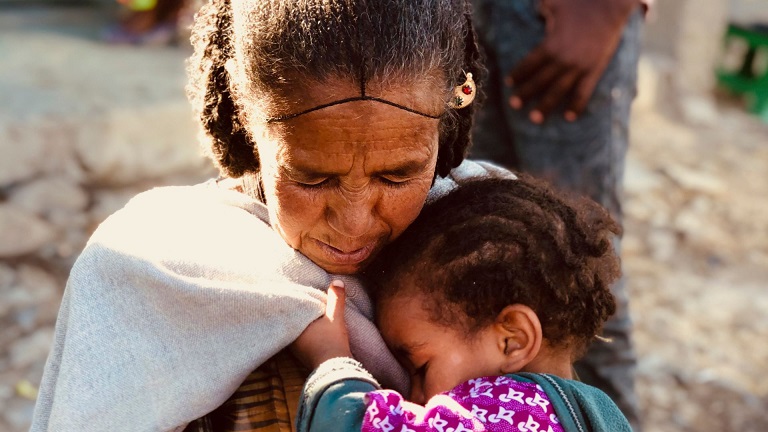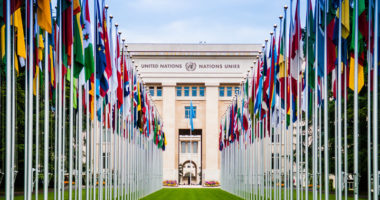The ICRC has been present in Ethiopia since the 1977 Ethio-Somalia armed conflict. However, the eruption of conflict in northern Ethiopia between the Ethiopian armed forces and the Tigray People’s Liberation Front, or TPLF, in November 2020 led to a significant increase in humanitarian needs and a consequent upscaling of operations, including legal support.
In this week’s episode of the ICRC Humanitarian Law and Policy podcast, Humanity in War, podcast host Elizabeth Rushing is joined by Romaric Ferraro, the ICRC’s operational legal adviser based in Addis Ababa to discuss the ongoing conflicts in Ethiopia as well as the response to the humanitarian needs caused by them.
Let’s dive right into what is garnering most of the global attention at the moment, the armed conflict in Ethiopia’s northern Tigray region. The focus on the conflict is understandable, as it has destroyed so many lives and livelihoods, but at the same time, there are also other ongoing conflicts in the country as well.
Last November, two years after the conflict erupted, the AU brokered a cessation of hostilities agreement between the Ethiopian government and the TPLF. Could you please lay out the context for us? How has the humanitarian situation evolved since the peace deal was signed?
Thank you very much for this question, which is very timely. The peace agreement has certainly helped to ease the situation in the north of the country. Humanitarian access has improved; more routes have been opened, which allows to better address the needs of the civilian population affected by the armed conflict and allows to get access to more hard-to-reach areas. Efforts have also been undertaken to re-establish essential services, such as phone and internet services and the banking system.
Nevertheless, the long-lasting effects of the armed conflict will certainly be felt for years, as the humanitarian consequences are huge. Thousands of people have been displaced, essential infrastructure has been destroyed or damaged, and weapon contamination has reached very concerning levels in some areas. Many people have also needs in terms of the protection of their family links and they will need to know about the fate and whereabouts of their loved ones.
It is interesting to see that the authorities have currently launched, in the framework of the peace agreement, a very interesting process of consultation on transitional justice which should allow to find the right balance between the need for accountability and truth, and to find solutions to foster peace, reconciliation, and reparation. In that context, we have recalled to the authorities the importance of taking into account the right to know, which translates into the obligation of the authorities to provide information about the whereabouts of the persons who could have gone missing during the conflict and to offer individual support to the families of the missing persons. The authorities need also to ensure that there will be no impunity for war crimes, as under international humanitarian law there is an obligation to repress the serious violations of IHL, which are war crimes. It is also important to remind that other armed conflicts are still provoking severe humanitarian consequences in other parts of the country.
It’s very encouraging to hear the increase of access in the country, which is, as we know, a prerequisite to any support that we can give. You also mentioned displacement in the country. We all know that’s a massive scale at the moment, and that is one of many indicators that a situation is rife with other humanitarian needs as well.
In 2021, conflict and violence triggered more than 5.1 million new displacements. That’s three times the number in 2020 and the highest annual figure ever recorded of displacement in a single country. Has there been a coherent operational and legal response to this quite overwhelming displacement of people?
We can say that the responses to internal displacement by the Ethiopian government have been largely focused on life-saving humanitarian action above all the provision of emergency assistance. The authorities had already attempted in the past to design responses to the need of the internally displaced persons. For example, in 2019, they launched a durable solutions initiative to ensure a transition from emergency assistance to a development-oriented assistance. In 2021, Ethiopia ratified the Kampala Convention and initiated steps to work towards a comprehensive framework to guide responses to internal displacement.
This process is still ongoing. It’s interesting to see that the authorities have set up an inter-ministerial task force (IMTF) to address several issues arising from the effect of the armed conflict, including the investigation of the crimes committed during the conflict, to address sexual- and gender-based violence, and to better manage the plights created by a very important phenomenon of internal displacement. Through the IMTF, a working group has been set up to prepare a draft law to implement the African Union Kampala Convention on the Protection and Assistance to Internally Displaced Persons. It is important to remember that the Kampala Convention is the only binding instrument in the world to address the issues faced by internally displaced persons in terms of protection and assistance. So far, very few states have adopted a comprehensive legislation to implement this treaty.
Ethiopia has now a timely opportunity to do so, and the good thing is that the ICRC was able to provide technical and legal support to the content of the draft law, to reflect properly IHL obligations. We have observed with satisfaction the openness of the authorities to receive recommendations on how to improve the draft law. We really hope that the authorities will be now able to approve this draft law and we encourage them to do so. One of the key aspects to operationalize the provisions of the Kampala Convention will be to put in place an institutional framework, which clearly sets the responsibilities between the different ministries and agencies in charge of the attention to the internally displaced persons.
Another crucial aspect is to be able to offer durable solutions to IDPs. As the return is not always the best durable solution, local integration or resettlement in another part of the country are also options to be considered. To be able to do this, relevant data on the number and the situation of IDPs need to be collected and a national policy on internal displacement needs to be promoted.
Against the backdrop of such immense human suffering, we do always have to cling to the more positive news. Hearing that there’s a lot of thinking already going into durable solutions is very encouraging to hear. In my experience, the thinking on durable solutions comes often too late. So, we have to cling on to the positive news where we can. And that indeed, is encouraging.
My next question relates to the issue of weapons contamination in the country, which is a scourge that often outlives the conflict itself and wreaks havoc on the civilian population, particularly young children who can mistake weapons for toys or shiny, fun objects to play with. What is the situation of weapons contamination in Ethiopia at the moment, and what needs to happen to improve it?
The ICRC has already carried out an assessment in the field that shows that the situation is very concerning. Many areas have been affected by weapon contamination due to the hostilities that happened during the last years. The exact nature of the threat posed by these weapons varies depending on the nature of the conflict and the weapons used. In addition to explosive remnants of war, such as grenades, mortars, cluster munitions, bombs and missiles, the problem often encompasses unstable or insecure munitions stockpiles and the proliferation of small arms and light weapons.
To reflect this reality, the term weapon contamination is used by the ICRC as an umbrella term, for all the operational activities aimed at reducing the resultant impact on the civilian population. Explosive remnants of war are a widespread problem affecting many countries. They include unexploded ordnance and abandoned explosive ordnance. They include explosive munitions that have failed to explode after being fired or launched, so-called UXOs, or have been left behind by a party to the conflict, so-called AXOs or abandoned explosive ordnance. Artillery shells, grenades, mortar shells, rockets, missiles and other explosive munitions as well as improvised explosive devices may all become explosive remnants of war.
We have to stress that explosive remnants of war aggravate civilian suffering during and after hostilities. They can impede access to health care facilities, restrict movement, impede access to schools, homes, and fertile land, hinder the delivery of humanitarian assistance and prevent the proper operation and maintenance of essential services. Moreover, explosive remnants of war pose a lethal hazard to civilians, notably, as you said, children long after active hostilities have ended. They prevent the return of displaced persons, significantly delay reconstruction efforts, and impede socio-economic development.
In Ethiopia, it has been observed in the context that children were disproportionately affected due to their natural curiosity and lack of understanding of the risk and as a consequence of tampering with explosive remnants of war. In other areas, after several incidents, the presence of explosive remnants of war put schools, dwellings, and fertile land out of use due to the fear of injury or death of the civilian population.
The Convention on Conventional Weapons and its additional protocols offer a solution to address the humanitarian consequences provoked by the presence of these explosive remnants of war. It provides a robust framework of obligations to prevent and mitigate the risk and devastating humanitarian consequences of these weapons that keep on killing. Parties to armed conflict must do everything feasible to prevent the occurrence of UXOs to ensure and facilitate its clearance and to warn civilians of its existence in order to prevent deaths or injuries and to adequately assist victims.
Protocol V of the Convention on Conventional Weapons on Explosive Remnants of War is a valuable tool in this regard and all states should join it and fully implement it without delay. Protocol V lays down obligations with regard to explosive remnants of war aimed at minimizing their risks and effects in post-conflict situations. Protocol V applies in the context of both, international and non-international armed conflict and their aftermath and binds all parties to conflict. In Ethiopia, we are currently engaging with the authorities on a dialogue to encourage them to consider participating to the Convention on Conventional Weapons and its protocols, including the Protocol V on Explosive Remnants of War. We are also starting a risk awareness program with the civilian population in the areas most affected by weapon contamination in collaboration with the Ethiopian Red Cross Society.
Thank you, Romaric, for giving us a very comprehensive overview of the legal toolbox available to bringing us towards hopefully a mine-free Ethiopia in the future.
My next question relates to the issue of sexual violence, particularly conflict-related, which remains a major humanitarian concern in Ethiopia. Could you please outline the different prevention and risk mitigation and response activities the ICRC is carrying out to support people affected by this crisis, and also what the national response has been, the current Ethiopian legal framework, and what, if any, steps need to be taken for it to be consistent with international humanitarian legal standards?
Unfortunately, it has been acknowledged by all actors in the country that sexual violence has been used widely and has been documented widely as well, during the different armed conflicts in the country, triggering even the government to put in place, as I explained at the beginning of the interview, a specific working group on how to address sexual violence due to the armed conflict.
The delegation is currently carrying out a number of activities with the authorities at the national and regional levels to alleviate the suffering of the victims of sexual violence. We have, for example, supported several one-stop centers which have been put in place to assist victims of sexual violence and several health facilities in Tigray, Amhara and Oromia regions. The delegation has provided medications and basic materials, including dignity kits and food. We have also trained health staff from the Amhara, Oromia and Tigray regions on the clinical management of rape. We also support those safe houses in Tigray and in the Amhara regions with their operational costs by supporting the cost of the rent, the food, the generator, their basic material, including dignity kits and services to restore family links, to trace and connect the victims with their loved ones.
We have also helped to establish referral pathways for survivors in 20 areas, in Tigray, Amhara, Afar, Oromia, Somalia and Addis Ababa. The ICRC has also provided individual support for survivors of sexual violence in Tigray, Amhara, Oromia, Jijiga and Addis Ababa, including safe referrals to medical services, economic support and RFL services. The reminder of the prohibition of sexual violence has been systematically as well incorporated into the training sessions that the delegation carries out with armed actors. In total, more than 430 police officers, investigators, and prosecutors have participated in dedicated trainings on the investigations of sexual violence and international humanitarian law.
As far as the legal framework is concerned and to address sexual violence, the delegation has carried out a study on the legal framework applicable to sexual violence in Ethiopia, which has allowed us to gain a better understanding and knowledge about how much the domestic legal framework is in line with international norms related to sexual and gender-based violence. It is encouraging to see that the national legislation does take into account a series of war crimes, including crimes related to sexual violence. Nevertheless, the study shows that some amendments would be required to ensure a better prosecution of the person suspected of having committed war crimes related to sexual violence.
A mobilization of all actors concerned, including the executive, the legislative and the judicial power is now necessary to make the amendments to the national legislation. The study has also shown that more measures of protection and access to health services need to be promoted.
My last question goes right to the core of the ICRC’s work, our fundamental principles. As with every conflict-affected region where we work, the humanitarian principles of humanity, impartiality, neutrality, and independence serve as a crucial compass and operational tool in highly polarized situations. Can you share any examples of how the principles were used successfully or when they were challenged during your time in the country so far?
I think that in the context of Ethiopia, the ICRC has been able to prove that it is a predictable organization that abides by the principle it promotes, namely humanity, impartiality, neutrality, and independence. We have implemented an all-Ethiopia approach through which we have served the needs of the civilian population, not only in Tigray but also in all the other regions of the country, which are affected by other armed conflicts, namely in Amhara, Oromia, Afar and Somalia regions. It is quite satisfactory to see that we could engage in a fruitful dialogue on the respect of IHL with all parties to the different armed conflicts, with both governmental forces and non-state armed groups through our bilateral and confidential approach. It is also very positive to say that the parties to the conflict have requested our help to act as a neutral intermediary.
At the request of the parties to the Pretoria peace agreement, we have been able, for example, to support the transportation of negotiators to different parts of the country. Since our neutrality has been perceived as genuine, both the Tigrayan and federal authorities have not hesitated to request the support of the ICRC to better shape their policies in relation to the implementation and respect of IHL and to share with us the good practices they have put in place in order to better respect IHL.
See also
- Cordula Droege, Eirini Giorgou, Elizabeth Rushing, How does international humanitarian law develop?, April 13, 2023
- Mariana Chacón Lozano, Elizabeth Rushing, International humanitarian law and policy in Colombia: progress and challenges, March 9, 2023
- Nils Melzer, Elizabeth Rushing, Humanitarian neutrality in contemporary armed conflict: a conversation with Nils Melzer, January 26, 2023







Comments